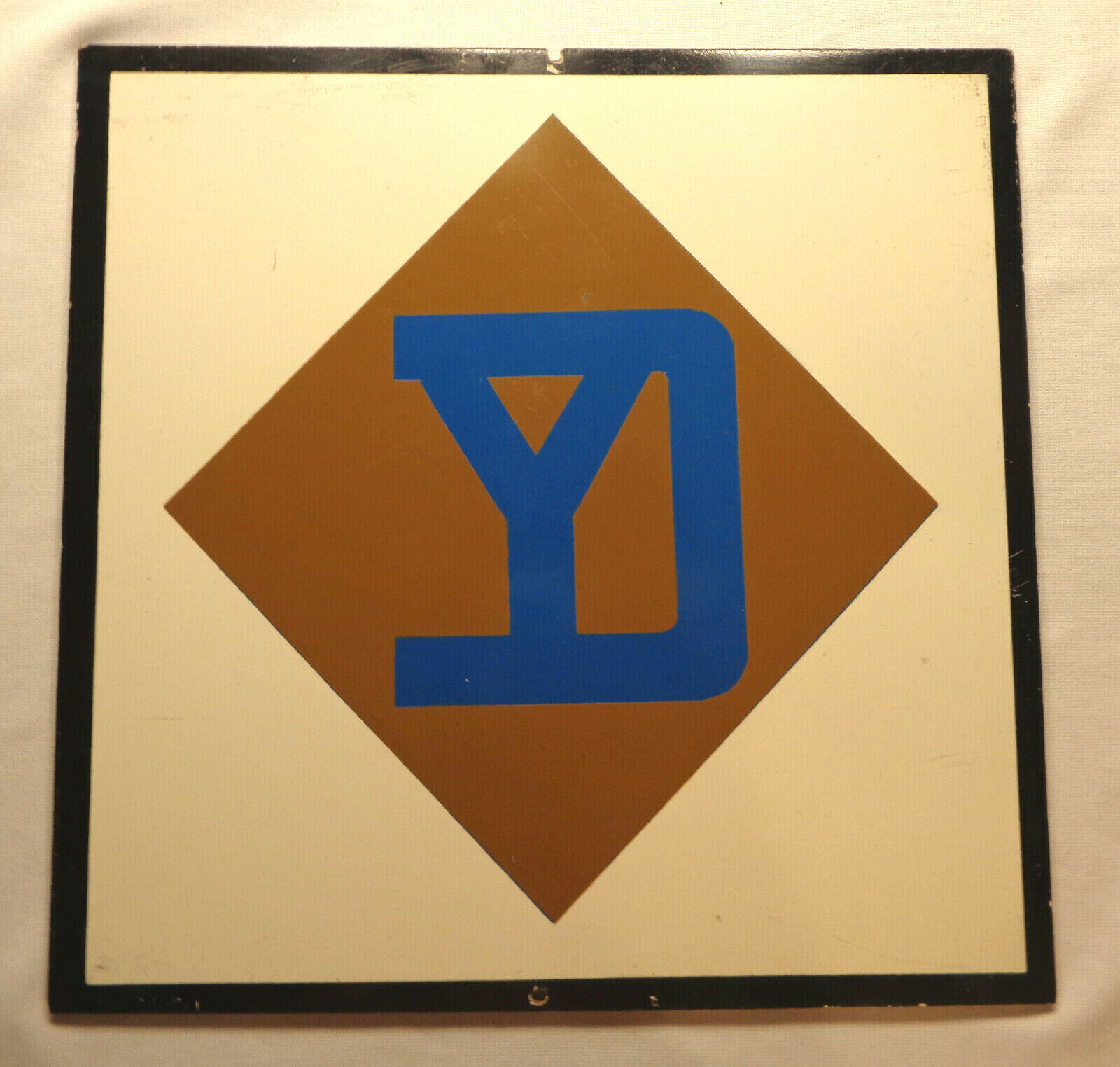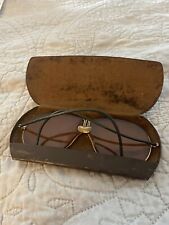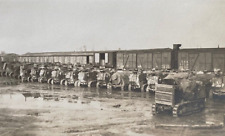When you click on links to various merchants on this site and make a purchase, this can result in this site earning a commission. Affiliate programs and affiliations include, but are not limited to, the eBay Partner Network.
This sign shows the early shoulder sleeve insignia (SSI) adopted by the 26th Infantry "Yankee" Division of the AEF in WW1. YOU WILL BE RECEIVING THIS SIGN ONLY, THE SET PICTURE IS FOR INFORMATIONAL PURPOSES.From a nearly? complete set of signs that are shown in the third picture. This set consists of each of the shoulder sleeve insignia used by units from the 1st world war, and are a very hard, glossy paint that I am assuming is an enamel on a confirmed Isorel board painted black, and measures 12 x 12 inches (30.48 cm). They are separated by that thin black paper packaging so common in that era. I am certain that it is Isorel by the cross like pattern of the pressing on the back which matches the Isorel pattern exactly. Isorel was the precursor to Masonite, which was not patented until 1924 and did not begin mass production until 1929. This set was likely produced some time after the war as most units did not have an insignia until then.
About the set:
This is obviously a very rare set and I am confident that it was issued by a significant organization, maybe even the US Military given the quality of the signs. I have had speculation on what they could have been for and it has been suggested that they might have been for a veterans group, but I think that they might have been used more for design purposes, possibly by a company that was in the business of supplying the newly adopted insignia patches to the various units in the US Military. Each of the 85 signs in the set have a hole on the top and bottom of the sign which I believe would be used for mounting, and they appear to have been extensively used. I will be offering each sign for sale individually so please be sure to stay tuned to my other listings as these become available.
About the 26th:
The 26th Infantry Division was an infantry division of the United States Army. A major formation of the Massachusetts Army National Guard, it was based in Boston, Massachusetts for most of its history. Today, the division's heritage is carried on by the 26th Maneuver Enhancement Brigade.Formed on 18 July 1917 and activated 22 August 1917 at Camp Edwards, MA, consisting of units from the New England area, the division's commander selected the nickname "Yankee Division" to highlight the division's geographic makeup. Sent to Europe in World War I as part of the American Expeditionary Forces, the division saw extensive combat in France. Sent to Europe once again for World War II, the division again fought through France, advancing into Germany and liberating the Gusen concentration camp before the end of the war.Following the end of World War II, the division remained as an active command in the National Guard, gradually expanding its command to contain units from other divisions which had been consolidated. However, the division was never called up to support any major contingencies or see major combat, and was eventually deactivated in 1993, reorganized as a brigade under the 29th Infantry Division. WW1The 26th Infantry Division was first constituted on 18 July 1917, three months after the American entry into World War I, as the 26th Division. It was formally activated on 22 August of that year in Boston, Massachusetts, and it was celebrated by Boston writers and by composers in pieces such as "The Yankee Division March" and "Battery A March." Shortly thereafter, the division commander, Major General C. R. Edwards, called a press conference to determine a nickname for the newly formed division. Edwards decided to settle on the suggestion of "Yankee Division" since all of the subordinate units of the division were from New England. Shortly thereafter, the division approved a shoulder sleeve insignia with a "YD" monogram to reflect this.On 21 September 1917, the division arrived at Saint-Nazaire, France. It was the second division of the American Expeditionary Force (AEF) to arrive on the Western Front at the time, and the first division wholly organized in the United States, joining the 1st Division. Two additional divisions completed the first wave of American troop deployment, with the 2nd Division formed in France and the 42nd Division arriving at St. Nazaire on 29 October. The division immediately moved to Neufchâteau for training, as most of the division's soldiers were raw recruits, new to military service. Because of this, much of the division's force was trained by the experienced French forces. It trained extensively with the other three US divisions, organized as the U.S. I Corps in January 1918, before being moved into a quiet sector of the trenches in February.The 26th Infantry Division remained in a relatively quiet region of the lines along the Chemin des Dames for several months before it relieved the 1st Division near Saint-Mihiel on 3 April. The line here taken over extended from the vicinity of Apremont, on the west, in front of Xivray-Marvoisin, Seicheprey, and Bois de Remieres, as far as the Bois de Jury, on the right, where the French line joined the American line. Division Headquarters were at Boucq.The stay of the division in this sector was marked by several serious encounters with the enemy, where considerable forces were engaged. There were furthermore almost nightly encounters between patrols or ambush parties, and the harassing fire of the artillery on both sides was very active.On 10, 12 and 13 April, the lines held by the 104th Infantry in Bois Brule (near Apremont), and by the French to the left, were heavily attacked by the Germans. At first the enemy secured a foothold in some advanced trenches which were not strongly held, but sturdy counterattacks succeeded in driving the enemy out with serious losses, and the line was entirely re-established.In late April, German infantry conducted a raid on positions of the 26th Division, one of the first attacks on Americans during the war. At 0400 on 20 April, German field artillery bombarded the 102nd Infantry's positions near Seicheprey before German [[Stormtrooper|stoßtruppen]] moved against the village. The artillery box barrage, continuing 36 hours, isolated American units. The Germans overwhelmed a machine gun company and two infantry companies of the 102nd and temporarily breached the trenches before elements of the division rallied and recaptured the village. The Germans withdrew before the division could counterattack but inflicted 634 casualties, including 80 killed, 424 wounded, and 130 captured, while losing over 600 men, including 150 killed of their own. Similar raids struck the 101st infantry at Flirey on 27 May, and the 103rd Infantry at Xivray-et-Marvoisin on 16 June, but were repulsed. The 26th Division was relieved by the 82nd Division on 28 June, moved by train to Meaux, and entered the line again northwest of Chateau Thierry, relieving the 2nd Division on 5 July.As the size of the AEF grew, the division was placed under command of I Corps in July. When the Aisne-Marne campaign began shortly thereafter, the division, under I Corps was placed under command of the French Sixth Army protecting its east flank. When the offensive began, the division advanced up the spine of the Marne salient for several weeks, pushing through Belleau Wood, moving 10 miles from 18 to 25 July. On 12 August it was pulled from the lines near Toul to prepare for the next offensive. The division was then a part of the offensive at Saint-Mihiel, during the Battle of Saint-Mihiel. The division then moved in position for the last major offensive of the war, at Meuse-Argonne. This campaign was the last of the war, as an armistice was signed shortly thereafter. During World War I the 26th Division spent 210 days in combat, and suffered 1,587 killed in action and 12,077 wounded in action. The division returned to the United States and was demobilized on 3 May 1919 at Camp Devens, Massachusetts.
shlf









